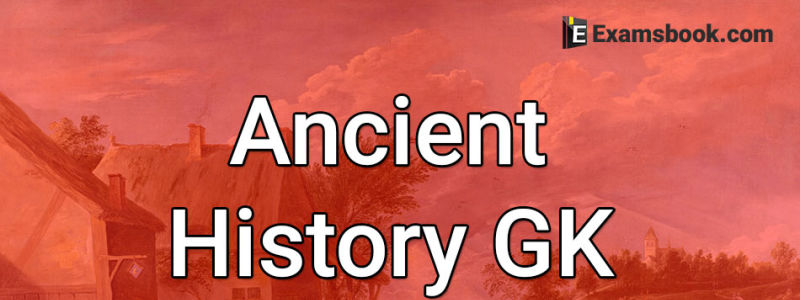Ancient Indian History Objective Questions and Answers for Competitive Exams

In the excavations of Harappan sites, bones of camels have been found at:
(A) Harappa
(B) Mohenjodaro
(C) Kalibangan
(D) Lothal
Correct Answer : C
Explanation :
camel bones have been found at the Harappan site of Kalibangan. Kalibangan is one of the archaeological sites of the ancient Indus Valley Civilization, located in present-day Rajasthan, India. The discovery of camel bones at Kalibangan suggests that camels were present in the region during the Harappan period, and they might have been used for various purposes by the ancient inhabitants, such as transportation or trade.
A clay model of plough has been found from:
(A) Rakhigarhi
(B) Mitathal
(C) Banawali
(D) Kalibangan
Correct Answer : C
Explanation :
A clay model of a plough has been found at the Harappan site of Banawali. Banawali is an archaeological site associated with the ancient Indus Valley Civilization, located in present-day Haryana, India. The discovery of such artifacts provides insights into the agricultural practices and technological advancements of the Harappan people. The plough was an essential tool for cultivation during that time.
First Jain council was held in _______.
(A) Kushinagar
(B) Ballabhi
(C) Pataliputra
(D) None of these
Correct Answer : C
Explanation :
The first Jain council, known as the First Jain Council of Pataliputra, was held in Pataliputra. This council is believed to have taken place around 300 BCE, shortly after the death of Lord Mahavira, the 24th Tirthankara of Jainism. The purpose of the council was to compile and codify the teachings of Mahavira, ensuring their preservation and transmission. Pataliputra, an ancient city in present-day Bihar, India, was a significant center for intellectual and religious activities during that period.
Who declared ‘the only hope for the India is from the masses. The upper classes are physically and morally dead’?
(A) Gandhi ji
(B) Nehru ji
(C) Swami Vivekananda
(D) None of the above
Correct Answer : C
Explanation :
This statement is attributed to Swami Vivekananda. He emphasized the importance of the masses in bringing about positive change in India and expressed a belief that the upper classes were lacking in both physical and moral vitality. Swami Vivekananda was a key figure in the introduction of Indian philosophies of Vedanta and Yoga to the Western world and played a significant role in the revitalization of Hinduism in India.
What was the name of the first newspaper to announce the partition of Bengal on July 6th 1905?
(A) Sanjibani
(B) Hansh
(C) Swaraj
(D) Kalantar
Correct Answer : A
Explanation :
In the year 1883, Krishna Kumar Mitra launched his Bengali journal named "Sanjibani". It was the first newspaper to announce the partition of Bengal on July 6th 1905.
In which year, Land Holder’s society was established in India?
(A) 1848
(B) 1850
(C) 1806
(D) 1838
Correct Answer : D
Explanation :
The Landholders' Society in India was established in 1838. This society was formed by large landowners in Bengal in response to the new land revenue policies introduced by the British East India Company. The society aimed to protect the interests of the landlords and address their grievances related to revenue assessment and land tenure systems.
Who among the following founded the Depressed Classes Mission of India?
(A) Achraya Vinoba Bhave
(B) Shantabai Kamble
(C) Vitthal Ramji Shinde
(D) Dr. Bhimrao Ambedkar
Correct Answer : C
Explanation :
Vitthal Ramji Shinde established this organization on 16 October 1906. His early spiritual awakening came from his readings of Sant Tukaram, Sant Eknath, and Sant Ramdas of Maharashtra. V.R.Shinde was a prominent campaigner on behalf of the Dalit movement. Aims of this mission were to try to get rid of untouchability, educate people from lower strata, help them to get Jobs, solve their social problems.
Who among the following was the founder of the Paris Indian Society?
(A) Bhikaji Kama
(B) Lala Hardayal
(C) S R Rana
(D) Taraknath
Correct Answer : A
Explanation :
Bhikaiji Cama moved to Paris where she founded the Paris Indian Society. Munchershah Burjorji Godrej and S.R. Rana were the co-founders of this society.
Who among the following is called the father of Nationalism in India?
(A) Dadabhai Naoroji
(B) Raja Rammohan Roy
(C) Bal Gangadhar Tilak
(D) Mahatma Gandhi
Correct Answer : B
Explanation :
Raja Ram Mohan Roy is known as the father of Indian Nationalism, the Father of Indian Renaissance and the Prophet of Indian Nationalism. He started the Brahmo Samaj in 1828. He also started Atmiya Sabha by attracting young men from Calcutta and carried on struggle against the religious and social evils.
In which year, the Danish East India company was formed?
(A) 1626
(B) 1617
(C) 1616
(D) 1615
Correct Answer : C
Explanation :
The Danish East India Company was formed in the year 1616. The company played a role in trade and colonial activities in Asia, including India, during the 17th and 18th centuries. It established trading posts and forts in various parts of India, particularly in Tranquebar (now Tharangambadi) on the southeastern coast.



